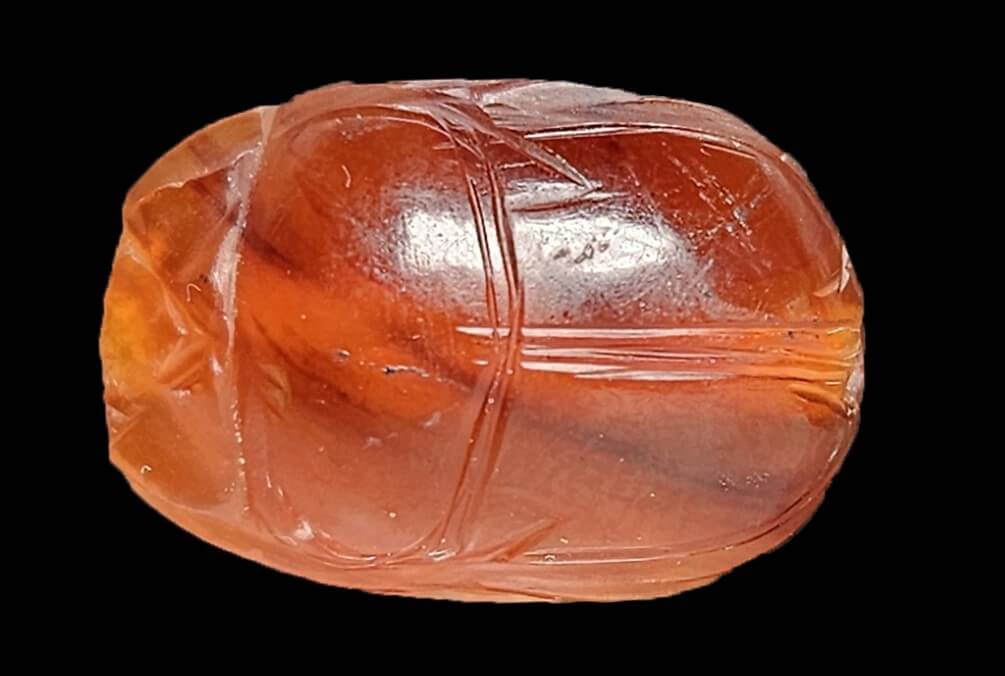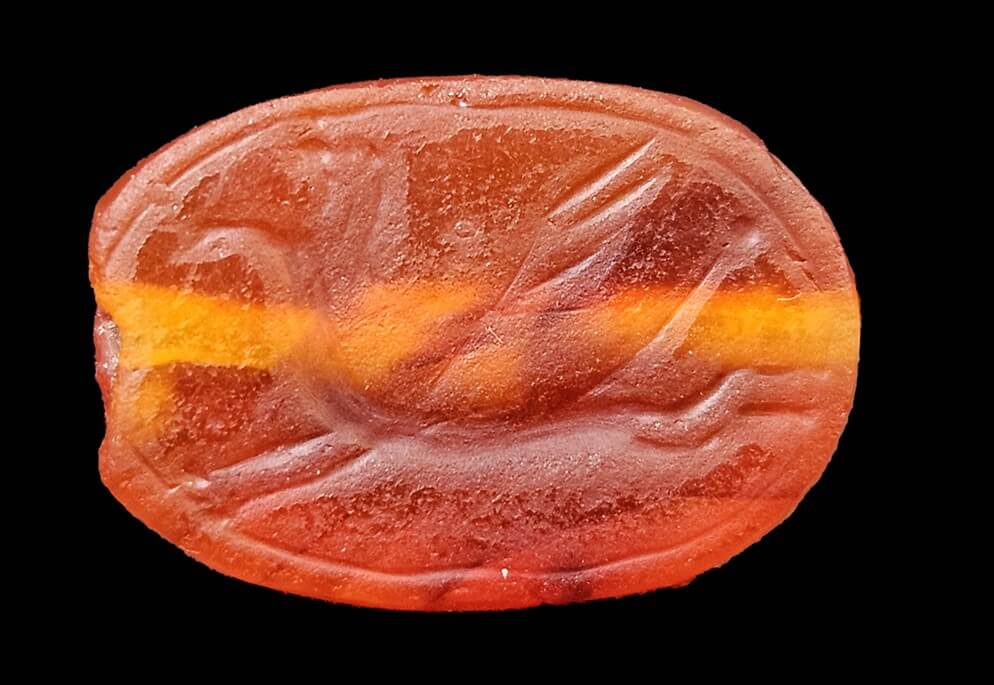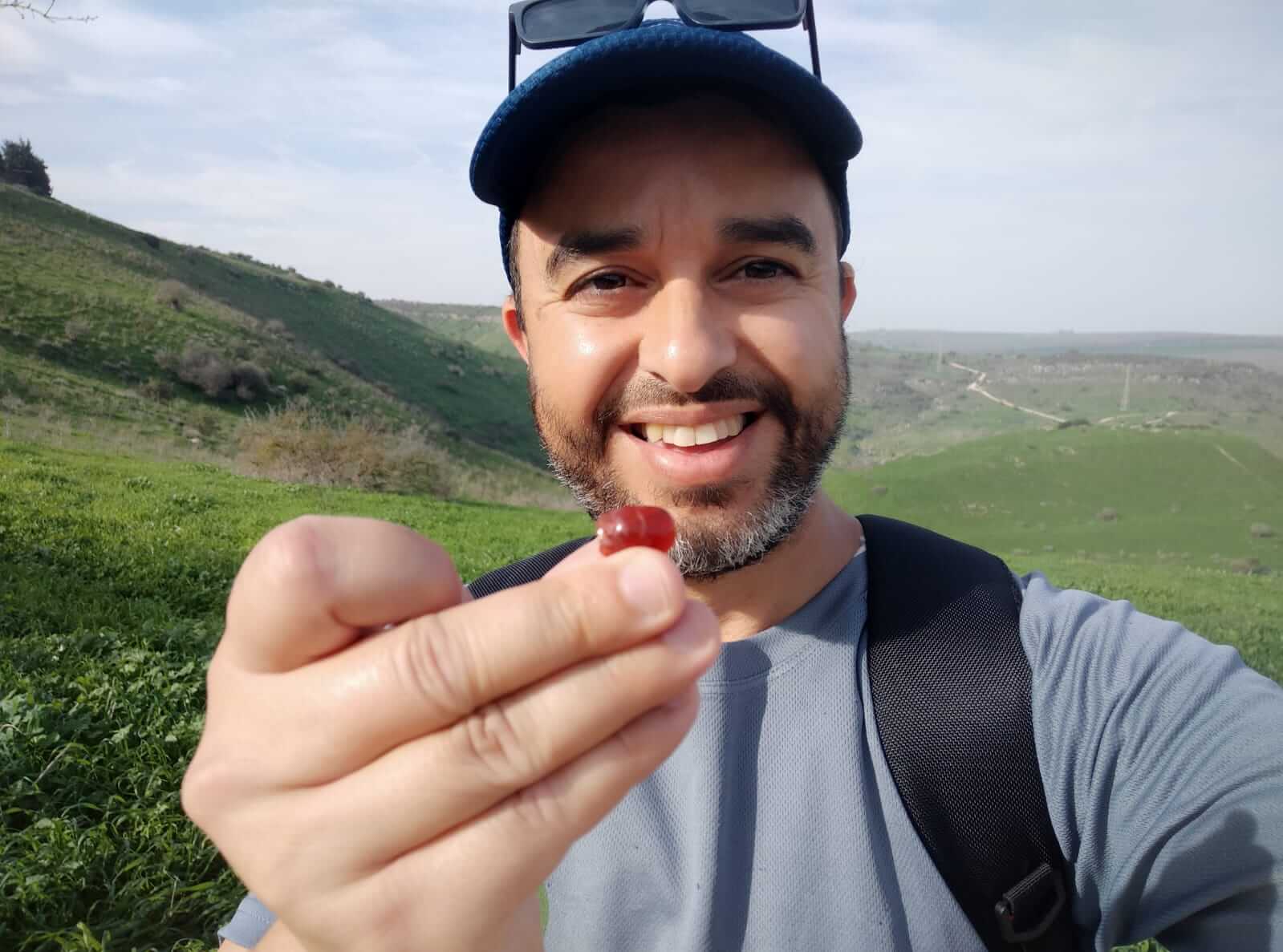The amulet may testify to the presence of an Assyrian (or perhaps Babylonian) official in the place almost 2,800 years ago * The rare find was transferred to the state treasures and the traveler received a certificate of appreciation from the Antiquities Authority

Erez Abrahamov, a 45-year-old resident of Paduel, recently took a walk in the Nahal Tabor Nature Reserve in the Lower Galilee, and found a scarab amulet dating back to the First Temple period about 2,800 years ago. "I received a two-day leave from the reserves and decided to take advantage of the two sunny days for a trip." Abraham's number." While walking I saw something shimmering in the ground. At first I thought it was a bead or an orange stone. After picking it up, I noticed that there were engravings on it that resembled a beetle. I called and reported the amazing find to the Antiquities Authority."
According to Nir Distelfeld, the supervisor of the robbery prevention unit at the Antiquities Authority, "I received a call from Marez, and I realized that he had found something special. I told him to take a good look at the other side - the flat side of the same scarab he found and check if there is an engraving on it. I immediately heard exclamations of admiration on the phone, and he informed me that he recognized a figure there."
According to Prof. Emeritus Othmer Kiel From the University of Friborg in Switzerland: "On the scarab, made of a semi-precious stone called carnelian, is depicted a gryphon (mythological animal) or a winged horse at a gallop. Similar scarabs have been dated to the 8th century BC."
"We thank Erez, who demonstrated good citizenship and handed over the rare scarab to the state's treasures," says Distelfeld. "We awarded me a certificate on behalf of the Antiquities Authority for demonstrating exemplary citizenship. Such a rare find can certainly expand our knowledge of the past." Distelfeld adds that "the beautiful scarab was found at the foot of Tel Rachsh, one of the most important hills in the north of the country. The site identified in the research with the city of "Anharet" (Yohshua 19:XNUMX) within the territory of the tribe of Issachar.

According to Dr. Itzik Paz, an archaeologist with the Antiquities Authority who excavated at Tel Rachsh, "One of the most important remains in the mound, dates back to the Iron Age (6th-7th centuries BC). During this period, a large citadel stood at the top of the mound, where plastered bathing facilities, halls and ceremonial rooms were found, which belonged to the Assyrian rule. This rule was, as we know, responsible for the destruction of the Kingdom of Israel. The scarab that was recently discovered at the foot of Tel Rachsh may belong to the period of Assyrian rule and may indicate the presence of Assyrian (or perhaps Babylonian) officials at Tel Rachsh during this period. The griffon that appears on the seal is a well-known artistic motif in the art of the ancient Near East, and is common on seals from the Iron Age. In light of the paucity of findings that have been discovered, so far, within the citadel, and if it is indeed possible to date the seal - based on artistic aspects, to the late Iron Age, there may be a possibility of linking the seal to an Assyrian presence in the citadel of Tel Rachsh, which may be a discovery of great significance!"
The scarab is a type of seal that was widely used throughout the ancient world from the 4th millennium BC onwards. The scarab seals were shaped like a dung beetle, hence their name. The name in Egyptian is derived from the verb "to be created", or "to be created", and this is because the Egyptians saw the scarab as a symbol of the embodiment of the Creator God.

The scarabs were fashioned from a wide variety of stones, including semi-precious stones such as amethyst and carnelian, but most of the scarabs were made from steatite - a soft talc stone, usually covered with a blue-green glaze. The glaze survived only in the dry climate of Egypt, therefore in the scarabs that were discovered in the country, it is almost impossible to find remains of glaze and the color of the original stone color is mostly gray-whitish. Against this background, the orange color of the scarab stands out.
According to Eli Escozido, director of the Antiquities Authority: "Like every winter, with the arrival of the rainy season, antiquities begin to "float" and rise above the surface. I implore the public to obey the Antiquities Law, and request - if you come across an archaeological find, report it to the Antiquities Authority from the field. The exact location of the object is extremely important in order to gain knowledge about it. The special scarab will be preserved in the state treasures, where we can research and learn more about it. The Antiquities Authority and the Ministry of Heritage thank Erez Abrahamov for delivering the important find."
More of the topic in Hayadan:
- A rare scarab seal, belonging to a senior official in the Kingdom of Egypt in the 13th dynasty of pharaohs (17th-18th centuries BC) was found in Tel Dor
- A mystery in Jerusalem: What were the mysterious canal facilities from the days of Kings Jehoash and Amaziah that were uncovered in the City of David National Park used for?
- Start Up Nation in Old Canaan

5 תגובות
Don't forget to mention that it is the red dragon idolatry that to this day the symbol is known both the old flags and in England there are to this day the flag received official status as the flag of Wales in 1959
"Treasures of the State"
You don't rule the Mishinat Israel, you got a little confused, you take all the antiquities of the country and scatter them to your associates!
I have already had the chance to see antiques in the hands of anyone connected to close associates or high-ranking people.
You are a slaughtered body that doesn't really reveal the treasures of the past to the public anyway, this is your way of keeping to yourselves...
And your most notable failure is the "Dead Sea Scrolls or the Judean Desert Scrolls"
And you are to blame for our history being looted under your noses!
He was wrong to say that if it is on the earth it belongs to him.
The Antiquities Authority behaved dishonestly and today they have to point this out to him.
Probably handed over something worth millions of dollars
Erez Avrahamov, a humble and humble man, qualified as a rabbi, recently finished writing a book that loves Adam and the Earth.
No wonder he got to discover such a find.
It's a candy I threw away